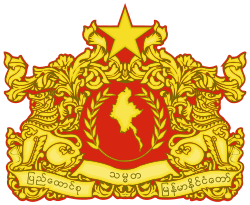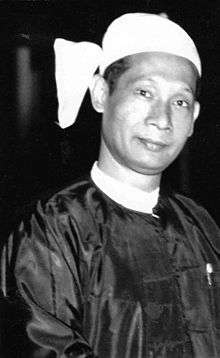1960 Burmese general election
General elections were held in Burma on 6 February 1960 to install a government to take over from General Ne Win's interim administration, established in October 1958. The military-led administration was credited for bringing stability and improving infrastructure in the country, though it suppressed some civil liberties.[1]
| |||||||||||||||||||||||||||||
All 250 seats in the Chamber of Deputies 126 seats needed for a majority | |||||||||||||||||||||||||||||
|---|---|---|---|---|---|---|---|---|---|---|---|---|---|---|---|---|---|---|---|---|---|---|---|---|---|---|---|---|---|
| Turnout | 66.0% | ||||||||||||||||||||||||||||
| |||||||||||||||||||||||||||||
| |||||||||||||||||||||||||||||
 |
|---|
| This article is part of a series on the politics and government of Myanmar |
|
|
Government
|
|
|
Related topics |
The elections were seen as not so much a contest between the Clean AFPFL of U Nu against the Stable AFPFL of Kyaw Nyein and Ba Swe, but a referendum on the policies of the interim military government between 1958 and 1960.[2] The result was a victory for the Clean AFPFL, which won 157 of the 250 seats in the Chamber of Deputies.
The elections set a precedent to other Middle Eastern and South Asian leaders, where the military voluntarily handed over to a civilian government and held free elections.[3] However, only two years after his election victory, U Nu was overthrown by a coup d'état led by General Ne Win on 2 March 1962.
Campaign
The Clean AFPFL, led by U Nu, and Stable AFPFL, led by U Kyaw Nyein and U Ba Swe, had been formed after a split in the main AFPFL party in June 1958. Until the military took over in October 1958, U Nu relied on the communists to retain a majority in parliament.[4]
Despite the formation of the two parties, there were no major ideological differences between them and their policies were similar, especially with regards to non-alignment, although the Stable faction favoured industrialisation and the Clean faction spoke more of agricultural development.[5] The Stable faction had given the impression it was favoured by the army, but, after realising the army was not as favoured as first thought, distanced itself.[5] It had also argued it represented stability.[6] Meanwhile, the "Clean" faction warned against the "dangers of fascist dictatorship",[7] and criticised the current leaders for their "drinking and womanising".[8] The communist NUF was severely repressed by the caretaker military government and was therefore outside the two main parties.[9]
The Clean AFPFL chose yellow to campaign, as it was the colour worn by monks, while the Stable AFPFL chose red and the National Union Front chose blue.[7]
Conduct
An estimated 10,000,000 Burmese were eligible to vote.[10] The military largely stayed away on voting day, although it was present at some ballot boxes. Boxes for the "Clean" faction featured pictures of U Nu which the "Stable" faction and other smaller parties alleged confused the voter into thinking they were voting for Nu personally.[9] Polls closed at 6pm and a crowd estimated at 20,000 gathered at the Sule Pagoda in the capital Rangoon to hear results as they were posted.[5] The "Clean" faction took all 9 seats in the capital including one they were prepared to concede, while the "Stable" faction had some strength in the countryside.[11]
Media coverage of the event was restricted to print media only and vigorously covered, but was largely ignored by the state-run Burma Broadcasting Service which had not aired opposition coverage since before the AFPFL split.[9]
Results
Voter turnout was 66%, then the highest in a Burmese election.[12] U Nu, remarking on his victory, said "I guess people like us".[7]
Chamber of Deputies
| Party | Votes | % | Seats | +/– |
|---|---|---|---|---|
| Clean AFPFL | 3,153,934 | 57.2 | 158 | New |
| Stable AFPFL | 1,694,052 | 30.7 | 41 | New |
| National United Front | 262,199 | 4.8 | 3 | –45 |
| Arakanese National Unity Organisation | 160,783 | 7.3 | 6 | 0 |
| United Hill People's Congress | 6 | –8 | ||
| Kachin National Congress | 3 | +1 | ||
| Mon National Front | 3 | New | ||
| People's Educational and Cultural Development Organisation | 2 | –2 | ||
| Chin National Organisation | 1 | New | ||
| Kayah National United League | 1 | New | ||
| Kayah Democratic League | 1 | New | ||
| All Nationalist Alliance | 0 | New | ||
| All-Shan State Organisation | 0 | –4 | ||
| Buddhist Democratic Party | 0 | New | ||
| Burma Democratic Party | 0 | 0 | ||
| Burma Nationalist Party | 0 | –1 | ||
| Independents | 16 | |||
| Vacant | – | – | 13 | – |
| Total | 5,513,895 | 100 | 250 | 0 |
| Registered voters/turnout | 10,000,000 | 66.0 | – | – |
| Source: The 1960 Elections Burma, Nohlen et al. | ||||
Chamber of Nationalities
| Party | Votes | % | Seats |
|---|---|---|---|
| Clean AFPFL | 53 | ||
| Stable AFPFL | 29 | ||
| Minority parties | 43 | ||
| Total | 125 | ||
| Source: Nohlen et al. | |||
References
- Bigelow, Lee S (1960). "The 1960 Elections in Burma". Far Eastern Survey. Institute of Pacific Relations. 29 (5): 70–74. doi:10.1525/as.1960.29.5.01p13582. JSTOR 3024046.
- Rotberg, Robert I (1998). Burma: prospects for a democratic future. Brookings Institution Press. p. 43. ISBN 978-0-8157-7581-2.
- Butwell, Richard; von der Mehden, Fred (1960). "The 1960 Election in Burma". Pacific Affairs. Pacific Affairs, University of British Columbia. 33 (2): 144–157. JSTOR 2752941.
- "General Ne Win bows out". The Glasgow Herald. 10 February 1960.
- Grant, Bruce (8 February 1960). "All Asia is watching Burma's democratic election". The Age.
- Associated Press (9 February 1960). "'Foes' of corruption win easily in Burma election". Herald-Journal.
- Associated Press (10 February 1960). "U Nu victory changes trend". The Spokesman-Review.
- Grant, Bruce (9 February 1960). "Burma states her policy". The Age.
- Butwell, Richard (1960). "The new political outlook in Burma". Far Eastern Survey. Institute of Pacific Relations. 29 (2): 21–27. doi:10.1525/as.1960.29.2.01p1337u. JSTOR 3024460.
- United Press International (7 February 1960). "Burma voters cast ballots for deputies". St. Petersburg Times.
- Associated Press (9 February 1960). "U Nu 'cleans' bidding for sweep in voting". Daytona Beach Morning Journal.
- Dieter Nohlen, Florian Grotz & Christof Hartmann (2001) Elections in Asia: A data handbook, Volume I, p603 ISBN 0-19-924958-X


